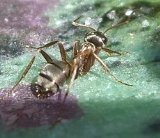
Formica sanguinea
Encyclopedia
Formica sanguinea is a species of slavemaker ant. It ranges from Central
and Northern Europe
through Russia
to Japan
, China
, and the Korean Peninsula
. This species is colored red and black with workers up to 7 mm long. Its common name comes from their practice of enslaving other species of ant
s.
A colony of F. sanguinea can live either by itself or as a social parasite on certain other Formica
species. In the latter case, a fertilized F. sanguinea queen
will enter the nest
of the host ant species and kill their queen. She then takes advantage of the workers who tend to her and her brood. F. sanguinea workers will also raid nearby nests, stealing larva
e and pupa
e to become future workers for F. sanguinea.

Central Europe
Central Europe or alternatively Middle Europe is a region of the European continent lying between the variously defined areas of Eastern and Western Europe...
and Northern Europe
Northern Europe
Northern Europe is the northern part or region of Europe. Northern Europe typically refers to the seven countries in the northern part of the European subcontinent which includes Denmark, Estonia, Latvia, Lithuania, Norway, Finland and Sweden...
through Russia
Russia
Russia or , officially known as both Russia and the Russian Federation , is a country in northern Eurasia. It is a federal semi-presidential republic, comprising 83 federal subjects...
to Japan
Japan
Japan is an island nation in East Asia. Located in the Pacific Ocean, it lies to the east of the Sea of Japan, China, North Korea, South Korea and Russia, stretching from the Sea of Okhotsk in the north to the East China Sea and Taiwan in the south...
, China
China
Chinese civilization may refer to:* China for more general discussion of the country.* Chinese culture* Greater China, the transnational community of ethnic Chinese.* History of China* Sinosphere, the area historically affected by Chinese culture...
, and the Korean Peninsula
Korean Peninsula
The Korean Peninsula is a peninsula in East Asia. It extends southwards for about 684 miles from continental Asia into the Pacific Ocean and is surrounded by the Sea of Japan to the south, and the Yellow Sea to the west, the Korea Strait connecting the first two bodies of water.Until the end of...
. This species is colored red and black with workers up to 7 mm long. Its common name comes from their practice of enslaving other species of ant
Ant
Ants are social insects of the family Formicidae and, along with the related wasps and bees, belong to the order Hymenoptera. Ants evolved from wasp-like ancestors in the mid-Cretaceous period between 110 and 130 million years ago and diversified after the rise of flowering plants. More than...
s.
A colony of F. sanguinea can live either by itself or as a social parasite on certain other Formica
Formica
Formica is a genus of ants of the family Formicidae, commonly known as wood ants, mound ants, or field ants. Formica is the type genus of the Formicidae, and of the subfamily Formicinae...
species. In the latter case, a fertilized F. sanguinea queen
Queen ant
A queen ant is an adult, reproducing female ant in an ant colony; generally she will be the mother of all the other ants in that colony. Some female ants do not need to mate to produce offspring, reproducing through asexual parthenogenesis or cloning and all of those offspring will be female.Ant...
will enter the nest
Ant colony
An ant colony is an underground lair where ants live, eat and mate. Colonies consist of a series of underground chambers, connected to each other and the surface of the earth by small tunnels. There are rooms for nurseries, food storage, and mating...
of the host ant species and kill their queen. She then takes advantage of the workers who tend to her and her brood. F. sanguinea workers will also raid nearby nests, stealing larva
Larva
A larva is a distinct juvenile form many animals undergo before metamorphosis into adults. Animals with indirect development such as insects, amphibians, or cnidarians typically have a larval phase of their life cycle...
e and pupa
Pupa
A pupa is the life stage of some insects undergoing transformation. The pupal stage is found only in holometabolous insects, those that undergo a complete metamorphosis, going through four life stages; embryo, larva, pupa and imago...
e to become future workers for F. sanguinea.


